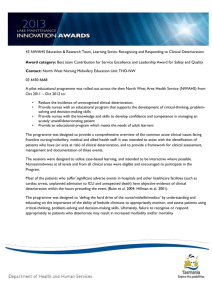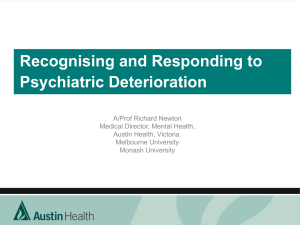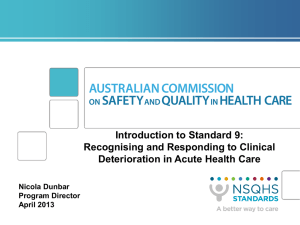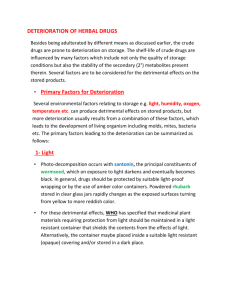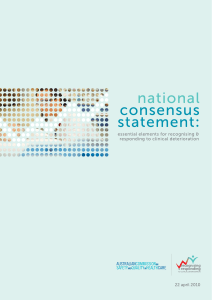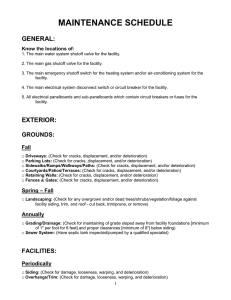ACT Health Directorate - Application Summary
advertisement
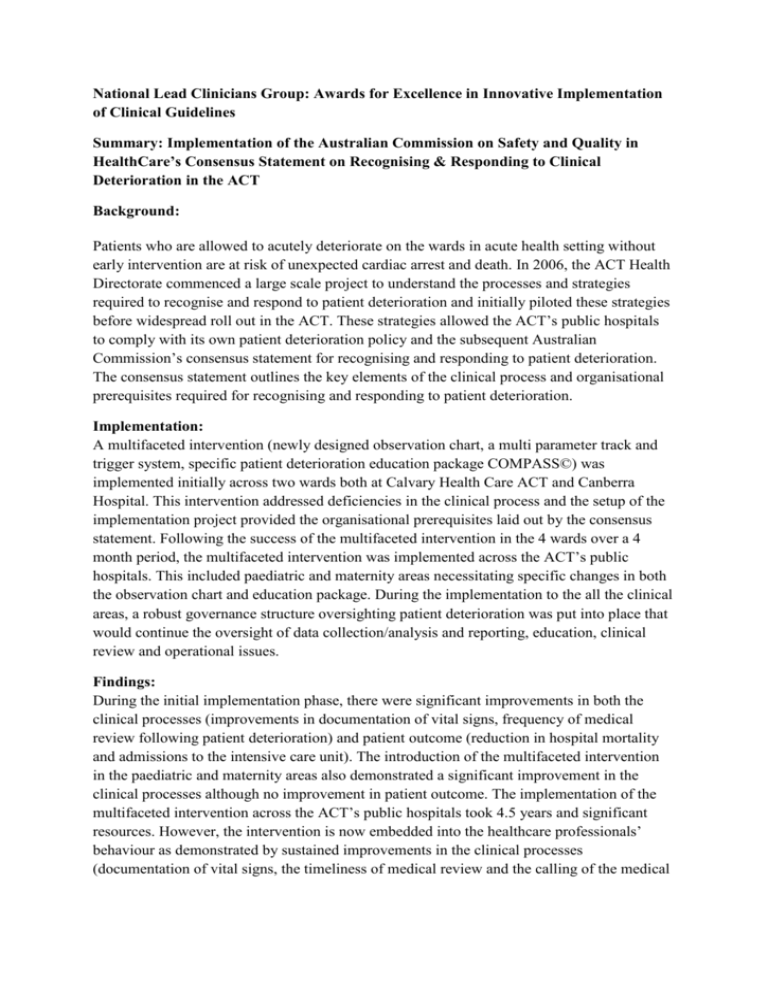
National Lead Clinicians Group: Awards for Excellence in Innovative Implementation of Clinical Guidelines Summary: Implementation of the Australian Commission on Safety and Quality in HealthCare’s Consensus Statement on Recognising & Responding to Clinical Deterioration in the ACT Background: Patients who are allowed to acutely deteriorate on the wards in acute health setting without early intervention are at risk of unexpected cardiac arrest and death. In 2006, the ACT Health Directorate commenced a large scale project to understand the processes and strategies required to recognise and respond to patient deterioration and initially piloted these strategies before widespread roll out in the ACT. These strategies allowed the ACT’s public hospitals to comply with its own patient deterioration policy and the subsequent Australian Commission’s consensus statement for recognising and responding to patient deterioration. The consensus statement outlines the key elements of the clinical process and organisational prerequisites required for recognising and responding to patient deterioration. Implementation: A multifaceted intervention (newly designed observation chart, a multi parameter track and trigger system, specific patient deterioration education package COMPASS©) was implemented initially across two wards both at Calvary Health Care ACT and Canberra Hospital. This intervention addressed deficiencies in the clinical process and the setup of the implementation project provided the organisational prerequisites laid out by the consensus statement. Following the success of the multifaceted intervention in the 4 wards over a 4 month period, the multifaceted intervention was implemented across the ACT’s public hospitals. This included paediatric and maternity areas necessitating specific changes in both the observation chart and education package. During the implementation to the all the clinical areas, a robust governance structure oversighting patient deterioration was put into place that would continue the oversight of data collection/analysis and reporting, education, clinical review and operational issues. Findings: During the initial implementation phase, there were significant improvements in both the clinical processes (improvements in documentation of vital signs, frequency of medical review following patient deterioration) and patient outcome (reduction in hospital mortality and admissions to the intensive care unit). The introduction of the multifaceted intervention in the paediatric and maternity areas also demonstrated a significant improvement in the clinical processes although no improvement in patient outcome. The implementation of the multifaceted intervention across the ACT’s public hospitals took 4.5 years and significant resources. However, the intervention is now embedded into the healthcare professionals’ behaviour as demonstrated by sustained improvements in the clinical processes (documentation of vital signs, the timeliness of medical review and the calling of the medical emergency team when appropriate). The Canberra Hospital’s standardised mortality ratio has also reduced in the same time period. Communication Strategy: A name for the education package, COMPASS©, and a logo for the project was developed so project material could be easily identified. Prior to, during and post implementation of the pilot study, the clinical champion and the project officer presented information and updates to all regular hospital fora Monthly newsletters were established during implementation and following implementation awards for the most compliant ward were established. A decision by the project steering committee was made to allow all the materials used for the intervention to be freely available on a website (compass.act.gov.au). This has allowed access to national and international healthcare organisations. Lessons Learned: The utilisation of project management methodology ensured tight adherence of timelines, provision of adequate time for planning, a robust communication plan with dissemination of results via: newsletters, public posters, peer review publications, national and international conferences, numerous internal meetings and regular reports. The formation of an effective project steering and working group (including consumers, senior health administrators, ward medical and nursing staff) allowed all concerns to be aired and senior decision makers to “make it happen” in the event of road blocks. The multifaceted intervention development involved nurses, doctors, allied health and educators from two local universities paving the way for a more successful implementation. Subsequent development of the education package for specific areas (maternity, paediatrics, psychiatry) provided relevance and a higher uptake of the package. Ongoing persistence and negotiation has allowed problems to be resolved. The use of data has been a powerful tool for influence alongside the involvement of a senior clinician to drive and sustain the intervention. Resourcing to allow for data collection and feedback has been critical to the sustainability of the intervention.
